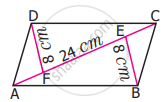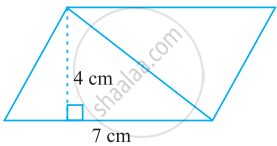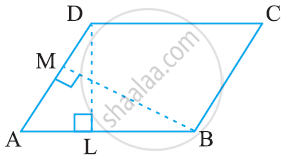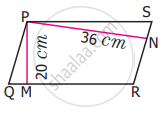Advertisements
Advertisements
प्रश्न
Find the area of the parallelogram ABCD if AC is 24 cm and BE = DF = 8 cm
उत्तर
Area of the parallelogram ABCD Area of the triangle = Area of the triangle ABC + Area of the triangle ADC
Area of the triangle = `1/2` × (base × height) sq.units
Area of ΔABC = `1/2` × 24 × 8 cm2
= 96 cm2
Area of ΔADC = `1/2` × 24 × 8 cm2
= 96 cm2
Area of the parallelogram ABCD = 96 + 96 = 192 cm2
APPEARS IN
संबंधित प्रश्न
Find the area of the following parallelogram:

PQRS is a parallelogram (see the given figure). QM is the height from Q to SR and QN is the height from Q to PS. If SR = 12 cm and QM = 7.6 cm. Find:
- the area of the parallelogram PQRS
- QN, if PS = 8 cm

DL and BM are the heights on sides AB and AD respectively of parallelogram ABCD (see the given figure). If the area of the parallelogram is 1470 cm2, AB = 35 cm and AD = 49 cm, find the length of BM and DL.

If area of a parallelogram is 29.6 sq cm and its base is 8 cm, find its height.
Find the missing values.
| Base | Height | Area |
| 18 cm | 5 cm |
Find the missing values.
| Base | Height | Area |
| 8 cm | 56 sq.m |
In a parallelogram PQRS (See the diagram) PM and PN are the heights corresponding to the sides QR and RS respectively. If the area of the parallelogram is 900 sq.cm and the length of PM and PN are 20 cm and 36 cm respectively, find the length of the sides QR and SR
Perpendicular dropped on the base of a parallelogram from the opposite vertex is known as the corresponding ______ of the base.
All parallelograms having equal areas have same perimeters.
Altitudes MN and MO of parallelogram MGHK are 8 cm and 4 cm long respectively in the below figure. One side GH is 6 cm long. Find the perimeter of MGHK.

